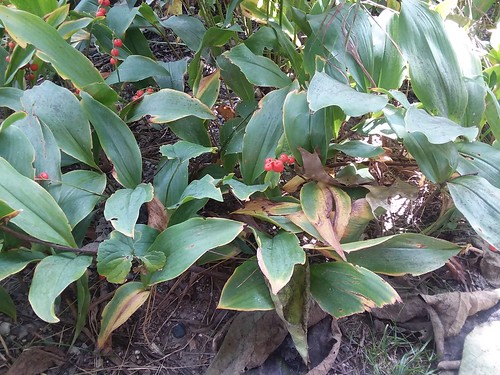Maianthemum racemosum
and Smilacina spp
Other Names Solomon's Seal, False Solomon's Seal, Bog False Solomon's Seal, Star-Flowered Solomon's Seal, Starry Solomon Plume, Starry Smilac, Spikenard, Scurvey berry
|
Table of Contents
|
General Information
As its name would imply, False Solomon's Seal looks quite a bit like True Solomon's-seal. The difference, at a glance, is in the flowers and berries. False Solomon's Seal has flower clusters at the top of the stem, while Solomon's Seal has flowers that hang down along the stem.
False Solomon's Seal is a member of the Lily family in the Maianthemum genus, also called the beadrubies. It is native to North American woodlands. It grows a single erect stem from a rhizome. Several alternate, parallel veined leaves clasp the stem all the way to the top.(Smiacina trifolia, or 3-leaved false Solomon's seal has three leaves) The flowers are white and star-shaped and appear in early spring in a loose bunch at the tip of the stem. They turn into red berries in the fall, which are savored by birds, especially the ruffed grouse.
Propagation
False Solomon's Seal enjoys a moist shady location with well-drained soil, neutral to slightly acidic. It will do well alongside a stream or pond and will tolerate some sun, but not full sun. It prefers a cooler situation and will benefit from mulching to keep the roots cool during hot summers. It can be grown from rhizomes or from seed, though the seed may take as much as 18 months to germinate. Plants can be divided in spring or early autumn.
Magical Attributes
This plant is a true survivor and often the first to return after a forest fire. Use it to help you get through hard times and to rebuild after your world has come crashing down.
Healing Attributes
The smoke of the root has been used to calm hysterics.
An infusion of the root has been used for constipation, rheumatism, as a general stomach tonic, and to regulate women's cycles. An infusion of the leaf has been used as birth control- 1/2 cup per day for no more than a week is said to prevent conception. A decoction of the leaf is said to be useful for colds and rheumatism, 1 cup 2-3 times per day.
Externally, the root relieves pain, has antiseptic qualities and stops bleeding. The dried powdered root is a useful thing to have on hand for first aid. The crushed, fresh root makes a soothing poultice for strains, sprains, boils, arthritis and swellings.
An infusion of the root has been used for inflamed eyes.
Culinary Use
The berries are edible and bittersweet but large quantities have a laxative affect. This is removed by cooking. Young leaves may be eaten raw or cooked and the young shoots may be eaten like asparagus. The root should be soaked in a bowl of water with a few teaspoons of baking soda added for several hours before cooking.
See Also
You can Print this page for your Book of Shadows
Do you have a question or something to add?





